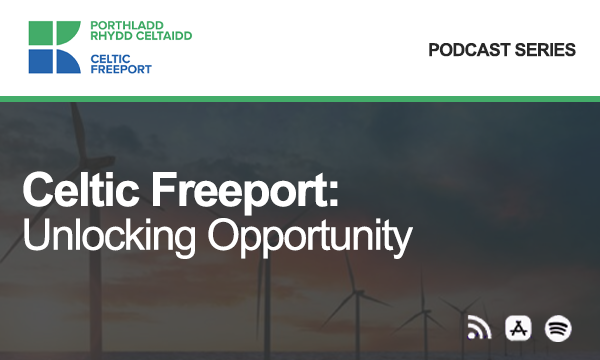
GUEST COLUMN:
Ben Burggraaf
CEO
Net Zero Industry Wales

The Celtic Freeport was never just an idea on its own. It was born out of the collaborative work that shaped the South Wales Industrial Cluster Plan, bringing together industry and public sector partners with one shared purpose: to safeguard and strengthen one of the UK’s most significant industrial regions, while accelerating its path to decarbonisation.
For decades, South Wales has experienced steady deindustrialisation. The Freeport is a chance to reverse that trend, but it’s more than just an economic development zone. It’s a mechanism to target investment where it’s needed most, in a region responsible for around 70% of Wales’ industrial emissions. That’s a significant challenge – but also a huge opportunity.
If we get this right, the Freeport can be a catalyst. Early projects like the development of renewable energy capacity at Dragon LNG or the carbon capture plans being progressed at the Pembroke Net Zero Centre are not isolated efforts. They’re part of a bigger chain reaction. With each step forward, we unlock the potential for further infrastructure, whether it’s CO₂ transport, hydrogen pipelines or floating offshore wind (FLOW) development. The benefits ripple out well beyond Milford Haven and Port Talbot.
But we also need to be clear-eyed about what it takes to sustain that momentum. Infrastructure doesn’t build itself. Investment doesn’t arrive without confidence. And confidence comes from clarity about roles, responsibilities, and long-term direction.
The UK Government’s recently unveiled Industrial Strategy and announcements on clean power and pricing support for heavy industry are welcome. But we need to go further. We need clarity on who is responsible for delivering against these strategies – not just in principle, but in practice. Who is accountable for pulling together public and private partners, for coordinating delivery, and for ensuring that Wales is equipped to meet its own ambitions?
We’ve already identified the scale of what’s possible. The analysis we’ve done with KPMG highlights more than £36 billion of potential investment over the next 25 years, with an estimated £290 billion contribution to GVA, over 25 years. That’s a compelling business case. But a good business case alone is not enough. We also need the mechanisms to deliver it.
That includes ensuring our industrial strengths aren’t left behind. Much of the discussion around Freeports and decarbonisation rightly focuses on new sectors such as hydrogen, FLOW and new forms of low-carbon manufacturing. But there’s a risk that we overlook the importance of existing industries and their ability to contribute to and benefit from this transition.
Companies like Dragon LNG, Valero, Tata Steel and others already within the Freeport footprint must be part of the picture. They can’t be left waiting while new opportunities are defined and whilst these opportunities are in delivery in the North of England & Scotland.
We need near-term investment, underpinned by UK Government financial support, to support the decarbonisation of these businesses now – not in ten years. That kind of bridging investment is crucial if we are to retain our industrial base while transforming it.
We also need long-term planning for infrastructure. That includes non-pipeline CO₂ transport routes to permanent storage, to help decarbonise gas-fired power and other key emitters. It also includes a hydrogen pipeline connecting Milford Haven and Port Talbot, linking a generation centre to a demand centre, with the potential to reintroduce high-value activities like primary steelmaking in future. It includes FLOW assembly, test and demonstration zones, and it includes a sensitive but strategic approach to grid interconnection across Wales.
This is not about small incremental change. It’s about building the conditions, i.e. significant low carbon infrastructure & access to globally competitive low carbon energy, to enable industrial decarbonisation at scale, supplying cleaner energy, creating a more resilient infrastructure, and delivering long-term economic prosperity. That kind of delivery programme requires structure. It needs proper governance, coordination and shared accountability.
My biggest ask to government is this: work with us, clearly and constructively, to define who is responsible for delivery. We cannot achieve the ambitions of the Celtic Freeport – or the broader Welsh and UK net zero goals – if it’s unclear who is leading and how decisions are being prioritised. These are large, complex, capital-intensive projects. They require the same rigour as any national infrastructure programme.
Wales has a real opportunity to lead in the clean energy transition while retaining its status as a cornerstone of the UK’s industrial base. But we need to get organised. We need a coherent story, shared ownership, and clear delivery responsibilities.
That’s how we unlock the investment we know is possible. That’s how we keep people in quality industrial jobs, while preparing for the technologies of the future. And that’s how we ensure South Wales remains not only an industrial heartland but also a leading force in a just and achievable net zero transition.
Ben Burggraaf talks about this and more in the Celtic Freeport: Unlocking Opportunity podcast episode How the Celtic Freeport is Powering Regional Decarbonisation. Listen to the podcast here.










